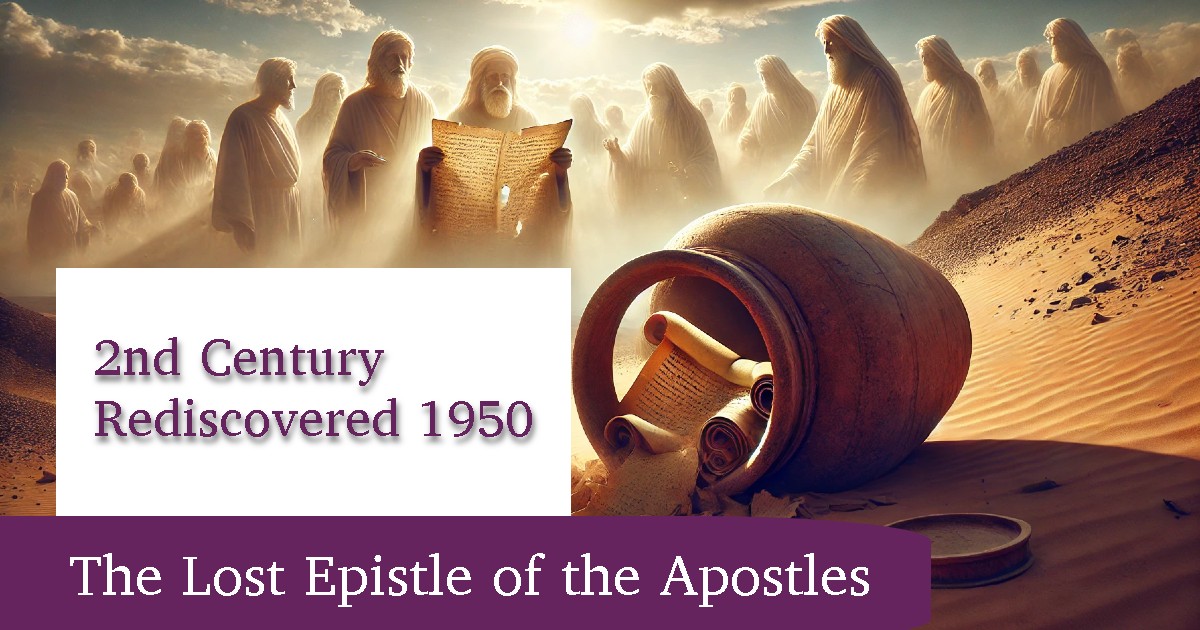A Forgotten Letter from the Apostles?
Imagine stumbling upon a long-lost letter written by all twelve apostles, a letter filled with prophecies, secret teachings, and visions of the resurrected Jesus. That’s exactly what the Epistle of the Apostles claims to be—a hidden gospel from the 2nd century that almost vanished into obscurity.
Unlike the letters of Paul or the canonical Gospels, this mysterious text presents a version of Christianity where the apostles act as a unified voice, declaring what they have seen, heard, and learned from Jesus himself. But where did it come from, and why was it buried by history?
The Discovery of the Epistle
For centuries, the Epistle of the Apostles was lost to history. Then, in the late 19th century, scholars uncovered an Ethiopic manuscript of this unusual gospel, followed by fragments in Latin and Coptic. These discoveries confirmed that the text was once widely circulated in the early Christian world but later suppressed or forgotten.
Dating to around 150 CE, this epistle is a fascinating mix of apocalyptic prophecy, theological argument, and narrative storytelling—a gospel disguised as a letter.
A Gospel Unlike Any Other
A Letter from All Twelve Apostles?
The text begins with a shocking claim: the apostles, acting together, are writing a letter to all Christians. This is highly unusual because, in the New Testament, letters are typically written by individual figures like Paul, Peter, or John. But here, the apostles speak as one, giving their collective testimony about Jesus.
The Resurrected Jesus Reveals Secrets
The apostles describe an extended post-resurrection conversation with Jesus, something the canonical Gospels barely touch on. Jesus not only confirms his divinity but also warns them about false teachers and future events, making this text partly a prophecy about the end times.
Key teachings from Jesus in the Epistle of the Apostles:
- Prophecies of the future – Jesus warns about heresies, false gospels, and leaders who will distort his message.
- A secret knowledge of Heaven – The apostles ask Jesus about the nature of Heaven, angels, and the final judgment.
- The Anti-Christ will come – Jesus describes an evil deceiver who will claim to be him but lead many astray.
The Birth of a Virgin? Not Mary—Adam!
One of the strangest elements of the text is that Jesus says Adam was born of a virgin—meaning that, just like Jesus, the first man was miraculously created. This reimagining of Genesis ties Adam’s creation to Jesus’ divine birth, reinforcing the idea that Christ is the “new Adam.”
A Direct Attack on Paul?
The Epistle of the Apostles contradicts Paul’s teachings in some key areas, especially regarding the role of visions and authority. It seems to reject the idea that people can receive revelations outside of what the apostles directly taught, possibly pushing back against the spiritual experiences Paul often emphasized.
Jesus Is Coming Back—Soon
The letter also carries an urgent apocalyptic message: Jesus is returning imminently. The apostles tell their readers to stay faithful, resist false teachings, and prepare for the end of days. This reflects the early Christian expectation that the Second Coming was just around the corner—an idea that later generations of Christians had to adjust as time went on.
Why Was This Letter Forgotten?
The Epistle of the Apostles was likely too radical and too different for mainstream Christianity. By the time the New Testament canon was forming, texts like this one were left out because:
- It challenges Paul’s authority, and Paul’s writings were central to early Christian doctrine.
- It contains strange theological ideas, like Adam being born of a virgin.
- It focuses on apocalyptic prophecy, which was falling out of favor as Christians adapted to living in a world where Jesus hadn’t returned yet.
Over time, copies of the letter disappeared, and it was largely forgotten—until modern scholars rediscovered it.
A Glimpse into Early Christian Beliefs
The Epistle of the Apostles is a fascinating look at the fluid and evolving nature of early Christianity. It reminds us that, in the 2nd century, different Christian groups were competing to define the faith. Some saw Christianity as a mystical revelation, others as a set of strict apostolic teachings, and still others as an urgent call to prepare for the end of the world.
This lost letter offers a snapshot of an alternative Christianity, one that might have become dominant—if history had played out differently.
References
- Schneemelcher, Wilhelm. New Testament Apocrypha: Writings Relating to the Apostles, Apocalypses and Related Subjects.
- Cameron, Ron. The Other Gospels: Non-Canonical Gospel Texts.
- Elliott, J.K. The Apocryphal New Testament: A Collection of Apocryphal Christian Literature in an English Translation.

